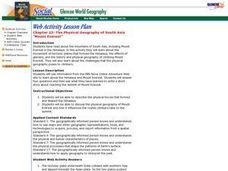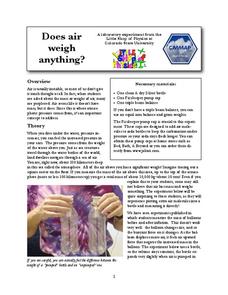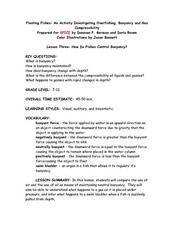Curated OER
Floating Fishes: Boat Sinking Lab
Cut milk cartons in half to make boats and let investigators attempt to sink them. They add dividing walls and observe what happens if marbles are put into only one of the newly formed compartments. Vocabulary is provided: buoyant force,...
Yale University
Airplane Mathematics
The history of aerodynamics is rich with experimentation and international collaboration. Author Joyce Bryant relays this dynamic past and provides math word problems using the formula of lift, the force that makes airplanes fly. She...
Curated OER
Balanced Forces
Young scholars are able to explain why football running backs benefit from having a lower center of gravity when opponents are trying to tackle them. They explain why racing cars are designed to have a low center of gravity. Students...
Curated OER
How Do Airplanes Stay off the Ground?
Students use balloons and string to duplicate Bernoulli's Principle of wing shape and its affect on liftoff.
Curated OER
Newton's Third Law
Learners use inquiry and observation to explore Newton's third law of motion: for every action there is a reaction. In this physics activity, students rotate through six stations set up with materials and picture directions illustrating...
Curated OER
Overarm throw/striking for force
Students practice overarm throw/stricking pattern, particularly: opposition in the legs, increased trunk rotation, preparatory back swing, and uncoiling of trunk, humerous and forearm.
Curated OER
The Physical Geography of South Asia
Learners describe the physical forces that formed and shaped the Himalaya, then discuss the physical geography of Mount Everest and how it influences the routes climbers take to the summit.
Curated OER
Biocomplexity Lab Activity: Density and Buoyancy of
Pupils investigate how the density of water changes the buoyancy of
water. Students create a hypothesis about what will happen when placing the
egg into the water.Pupils can research online different bodies of water (The Red Sea, The...
Curated OER
The Buoyancy Factor
Students examine why some objects float in water while others sink and the ability of something to float does not depend entirely on its weight. Archimedes' principle is introduced and buoyant force is discussed. Practice calculations...
Curated OER
Exploring Buoyancy
Learners use materials found at a resource table to design simple devices that will house instruments to take water samples from a tub of water. They design 3 instruments, each varying in density so that one will float, one will hover...
California Academy of Science
Buoyancy Bulls-Eye
Why does a seastar sink, but a jellyfish float? Through a fun investigation, learners examine the concept of buoyancy using simple household items. The challenge: create neutral buoyancy for an action figure in water. With ample teacher...
Mr. E. Science
Volcanoes
What is the difference between a shield volcano and a cinder cone volcano? How does the flow of lava influence the type of rock that's formed? A presentation on different aspects of volcanoes answers these questions for middle school...
Colorado State University
Does Air Weigh Anything?
Can you feel the weight of the air on your shoulders? Your classes may not believe that air has weight. A straightforward experiment asks individuals to weigh a bottle before and after adding air. Their results may surprise them!
Curated OER
Tornado in a Bottle
Students learn about the causes and properties of tornados. Students create a simulation of a tornado and observe its characteristics.
Curated OER
Newton's 3 Laws of Motion
In this Newton's 3 laws of motion learning exercise, students view examples of each law and draw 1 example of each law on their own. Students draw 3 pictures.
Curated OER
To Float or Not to Float - Density
Students experiment floating a variety of objects in various liquids. They discover how density affects the ability of an object to float and apply the concept of density to solve problems.
Curated OER
Ice Floats
Young scholars explore the changing density of water. In this physics instructional activity, students investigate how an object's density determines whether it will float or sink in water. They explain why this unique property of is...
Curated OER
Cantilevers
Students perform an experiment to find the linear relationship between the appllied weight and the bend of the cantilever. In this linear relationships activity, students follow detailed directions to set up an experiment. They add...
Curated OER
Density Review
In this density learning exercise, learners review how to calculate density and how to apply Archimedes' Principle, Boyle's Law, and Charles' Law. This learning exercise has 10 matching, 13 short answer, and 6 fill in the blank questions.
Curated OER
Buoyancy
In this buoyancy worksheet, students read about why objects float or sink. Students apply the Archimedes' Principle in a buoyancy lab. Students complete 1 graphic organizer.
Curated OER
Buoyancy-Why Things Float
In this buoyancy activity, students read about the principles behind objects floating including density, buoyancy and Archimedes' Principle. Students complete a buoyancy lab where they use a balloon and water and a film canister and...
Curated OER
Floating Fishes: How do Fishes Control Buoyancy?
Playing with balloons, water, oil, and bottles help put this lesson over the top! Participants use air-filled balloons in water tanks to experience gas compression. They also use oil-filled bottles to experiment with buoyancy. Included...
Curated OER
Build A Borneo Glider!
Learners construct a paper glider. In this physics of gliding lesson, students first learn about Borneo and it's rainforest habitat. After learners discover the way animals in Borneo glide from tree to tree, they use their newly acquired...
Curated OER
Support and Transport in Plants
All types of transport systems in a dicotyledon plant are detailed here, with clear labelled diagrams and notes for the specific structures and functions. The way that these systems have adapted, and how support is assisted by the...

























